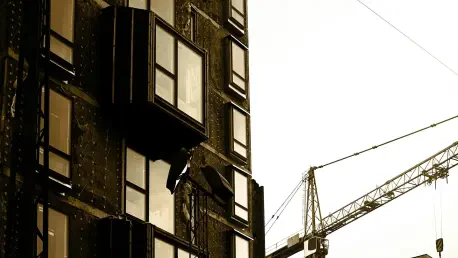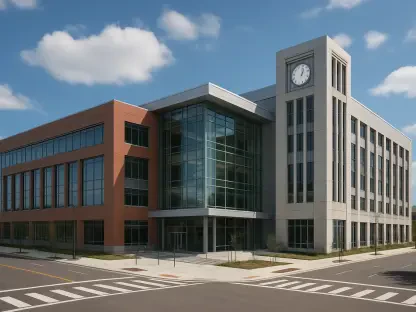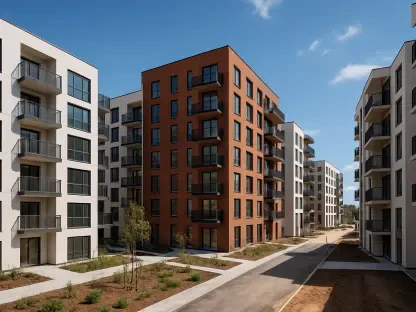Winnipeg’s Exchange District, known for its rich architectural history, is on the cusp of a transformative development project that seeks to harmonize heritage preservation with urban growth. At the center of this endeavor are the Sanford Building and Maw’s Garage on Bannatyne Avenue, representing significant historical structures now slated for conversion into part of a vibrant mixed-use development. This proposal has recently advanced due to a crucial decision by the council’s property and development committee. The committee supported a requested variance and partial heritage designation, paving the way for a nine-story structure comprising 114 residential units. This development marks a pivotal moment in Winnipeg’s urban trajectory, illustrating the challenge of integrating historical integrity with modernization demands.
Negotiating Heritage Preservation and Growth
A Balancing Act at the Exchange District
Winnipeg’s Exchange District faces the challenge of evolving in line with urban growth demands while preserving its historical allure. This dilemma is embodied in the current development proposal led by Ridgix Building Solutions Inc., which aims to rehabilitate and adapt landmark buildings to meet contemporary residential and commercial needs. At the center is developer Ryan Ridge’s vision of bridging the gap between preserving architectural heritage and fulfilling the city’s increasing population density requirements. The area, recognized for its architectural uniqueness, seeks evolution without undermining its cultural significance. This harmonious goal resonates with cities worldwide struggling to find equilibrium between conserving historical heritage and accommodating urban expansion.
The push for urban densification in the Exchange District reflects a broader global trend of revitalizing downtown regions with mixed-use developments, contributing to economic rejuvenation and heightened street activity. One particular advocacy for the project emphasizes the benefits of residential density and commercial vibrancy, including a potential public market on Princess Street that would offer lively engagement for residents and visitors alike. Such initiatives are seen as essential to revitalizing urban cores, fostering local economies, and enhancing the city’s overall landscape. However, integrating modern structures within centuries-old architecture poses significant challenges that demand careful negotiation and innovative solutions.
Community Division Highlights Diverse Perspectives
While the development initiative unveils promising prospects for the Exchange District’s economic growth, it also exposes deep community divides regarding historical preservation versus modernization. Supporters of the project spotlight the advantages of increased residential density and new commercial opportunities, further stimulating Winnipeg’s central business area. Yet, the opposition, comprising local residents and heritage advocates, vocalizes concerns regarding possible damage to surrounding historical sites and erosion of the district’s unique character. This apprehension was vividly expressed by Gregory Evans, representing appellant Alan Tate, in appeals before the city council committee. As debates persist across cities dealing with similar dilemmas, Winnipeg’s situation serves as a microcosm illustrating broader global struggles to navigate between historical preservation ethos and urban expansion demands.
Chris Graves, owner of the Kings Head Pub on Maw’s Garage premises, presents a nuanced understanding of the inherent trade-offs accompanying such developments. Despite potential disruptions, such as reduced parking affecting his business, Graves remains optimistic about the project’s long-term benefits while stressing dialogue and building integrity as pivotal elements for acceptance within the community. His perspective symbolizes a growing trend among urban stakeholders endeavoring to negotiate middle grounds that embrace change while honoring past legacies. These dynamics echo broader municipal approaches where forging partnerships and pursuing adaptive reuse are pivotal strategies toward reconciling historical preservation with evolving urban landscapes.
Procedural Journey and Strategic Implications
Municipal Governance Dynamics in Development
The procedural aspect of the development in Winnipeg underscores the critical role municipal governance plays in shaping urban environments. With city planner Kurtis Kowalke supporting the proposed project due to its alignment with urban density goals, Winnipeg exemplifies widespread municipal strategies where adaptive reuse and urban density act as catalysts for economic vibrancy. This approach aligns with global municipal endorsements emphasizing revitalization through architectural innovation, showcasing how strategic governance navigates complex urban dynamics. By maintaining a sustainable balance between increased density and conservation efforts, cities across the globe exemplify how proactive municipal involvement can drive urban evolution successfully without diminishing historical integrity.
The procedural rigor displayed in Winnipeg’s development narrative is also manifest in the requirement for a second heritage designation permit, underscoring commitment to thorough evaluation. Such actions ensure compliance with heritage norms and the preservation of historical integrity throughout development processes. This reflects municipalities worldwide engaged in comprehensive strategies that insist on careful, regulated urban planning reconciled with preserving historical landmarks. Adapting antiquated structures into modern frameworks necessitates detailed scrutiny and strategic decisions, championing innovative design that remains sensitive to historical narratives and regulatory imperatives shaping public perceptions of urban growth.
Collaboration as a Cornerstone of Progress
A crucial facet underscored through Winnipeg’s development narrative is the importance of collaboration. Heritage Winnipeg executive director Cindy Tugwell praises the commitment developers have shown in engaging actively with local heritage advocates, facilitating transparent dialogue and cooperative strategies. Such collaboration emerges as an instrumental component in saving historical artifacts from potential dilapidation while injecting renewed vitality into existent spaces. The discourse resonates with wider global movements where heritage conservation increasingly involves creative interventions allowing historical stories to linger amid evolving urban landscapes. Proactive engagement between various stakeholders can effectively push urban projects forward while garnering communal buy-in, ensuring both innovation and historical preservation coexist within evolving cityscapes.
The development effort illustrates broader urban trends where cities innovate by embracing adaptive reuse, integrating modern needs with historical preservation concepts. This facilitates communities in retaining cultural narratives while injecting contemporary relevance and vibrancy into aging structures. Such projects demonstrate how diplomacy, vision, and transparent communication among stakeholders are necessary tools within urban planning processes focused toward harmonizing heritage preservation with future renaissance. Proactive collaboration and adaptive reuse strategies spotlight opportunities for urban areas poised for transformation, balancing community expectations and municipal aspirations to ensure thriving environments amid historical richness.
Navigating Urban Development and Historical Preservation
The Exchange District in Winnipeg is grappling with the challenge of aligning with urban growth while maintaining its historical charm. This issue is highlighted by a development proposal from Ridgix Building Solutions Inc., which plans to refurbish landmark buildings for modern residential and commercial use. Developer Ryan Ridge envisions a balance between preserving architectural heritage and adapting to the city’s growing population needs. Known for its unique architecture, the area seeks growth without compromising its cultural essence, mirroring a global struggle to find a balance between conserving historical sites and accommodating urban growth.
Urban densification in the Exchange District is part of a worldwide trend of revitalizing downtowns with mixed-use projects that boost economic activity and street life. A notable aspect of this project is the potential for a public market on Princess Street, promising vibrant interaction for residents and visitors alike. These efforts are essential for revitalizing city centers, supporting local economies, and enhancing the urban landscape. However, integrating modern designs with ancient architecture presents challenges that require careful planning and innovative approaches.









